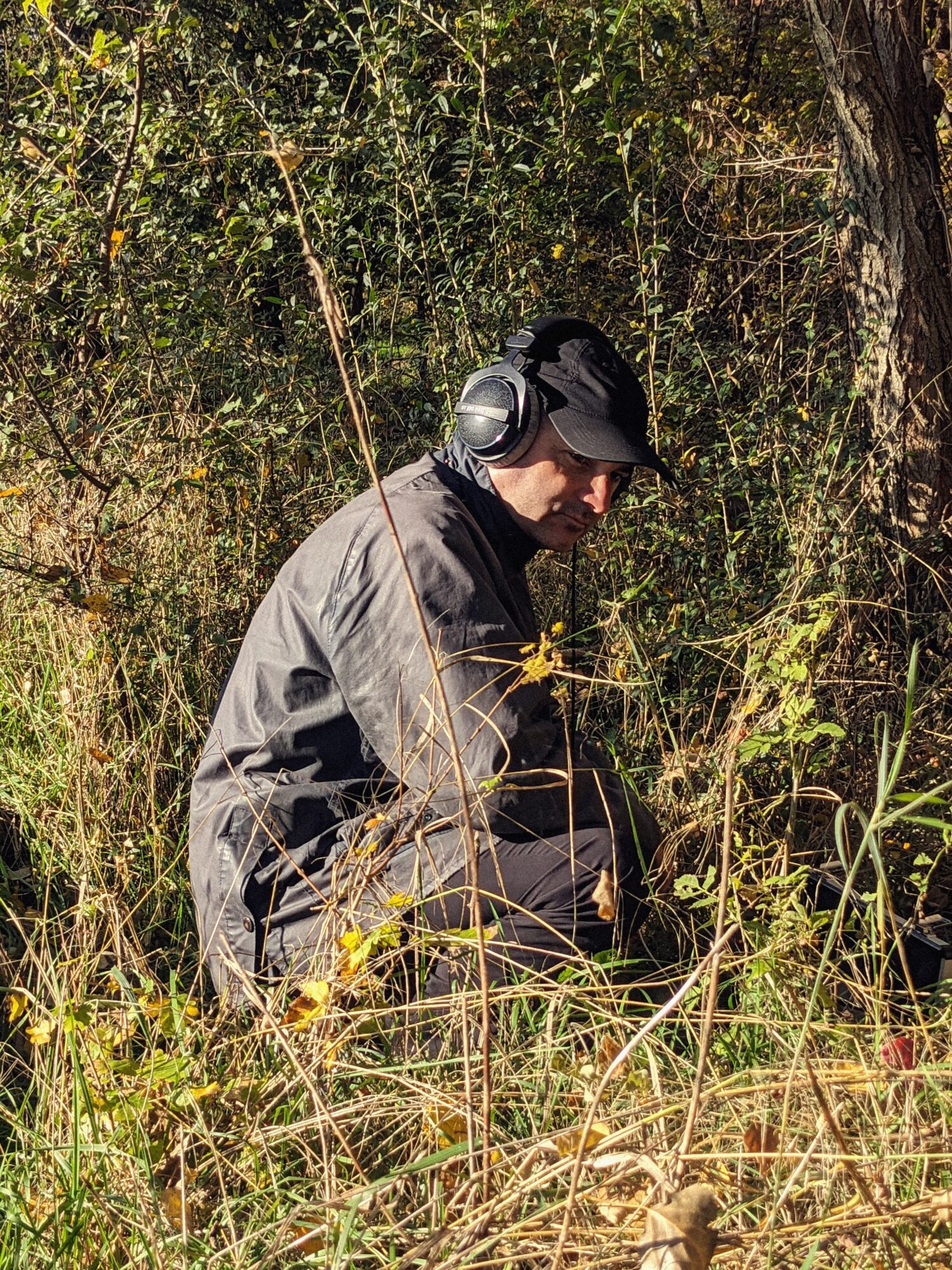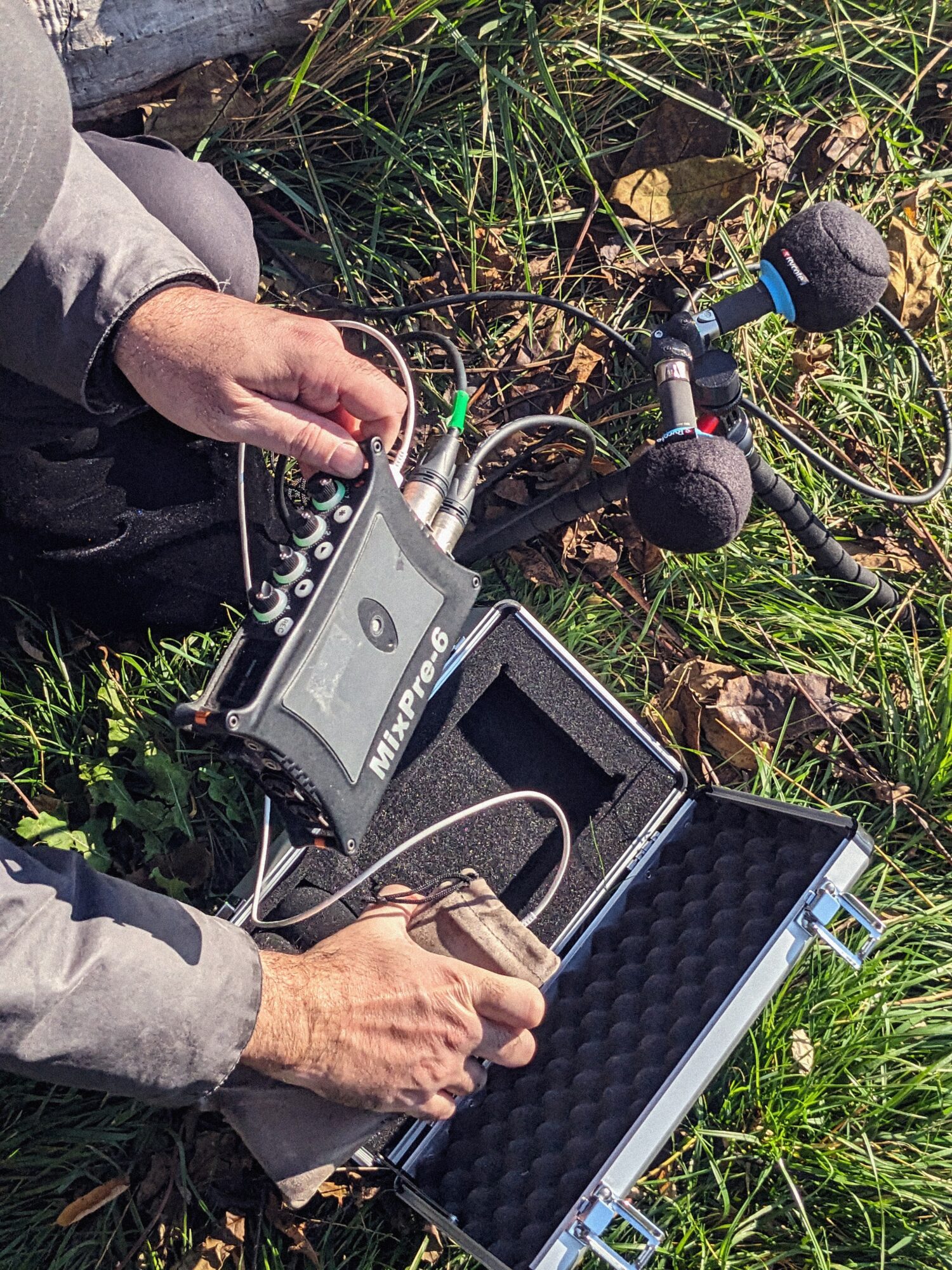“Insects are fascinating and underappreciated” – An interview with Robert Schwarz

What is your relationship to insects other than your interest in their sounds?
Insects are fascinating and kind of underappreciated. They are the most dominant group of animals on Earth, vastly outnumbering all other terrestrial animals and found almost everywhere. Countless insects are precious to us and society as we know it could not function without them. I think it is a good idea to establish more understanding of their importance for our ecosystem and our well-being.
Compared to us they are constructed peculiarly. They use their antennae to smell, some use their feet to taste, and others hear through specialized organs located in the abdomen, front legs, or antennae.
Do you hunt for specific species?
I listen to and record what I can find, especially in my own surroundings. Often field recordings are associated with exotic and spectacular places. For this project, I mostly tried to focus on more common situations. But in particular, I was interested in spatio-temporal patterns that occur within swarm behaviour, when some kind of synchronization is established. Many crickets like tree crickets for example, engage in “chorusing,” where one individual begins singing and others nearby join in. Occasionally, the individual pulses of those singing together may synchronize.
“I was interested in spatio-temporal patterns that occur within swarm behaviour”
This is very interesting, and I’ve always wondered why that is. It seems so counterintuitive, given that one individual aims to stand out?
Only at first glance. The chorus also creates an amplification that can carry the signals over much longer distances and then, the individual calls might still stand out because of other qualities like their unique timbre, pitch or rhythm.
In ecosystems where multiple calling species coexist, synchrony helps females to recognise their species. The acoustic niche hypothesis by Bernie Krause proposes that in a mature ecosystem, the singing of a species occupies a unique bandwidth in frequency and shifts in time to avoid competition, thus making communication efficient.
And finally, singing in a chorus is also more protective for the individual to be located by a predator.

Do cicadas and crickets differ in sound?
Crickets, locusts and grasshoppers all belong to the order of insects called Orthoptera (Heuschrecken). They typically stridulate, by rubbing two chitinous body parts against each other, for example, one leg against a pattern on their wings. This is a very basic way of sound production and communication and limited in complexity and loudness. We commonly describe these rhythmic sounds as chirp or chirrup.
Cicadas are very different and their typical calls are not produced by stridulation. Nevertheless, I have included some cicadas in my album. It is finally also chitinous structures that produce the sound, but much more complex and specialized than simple stridulation. Male Cicadas have special organs for sound production. A pair of tymbals is located dorsally on the sides of the basal abdominal segment just behind their wings. These tymbals consist of a posterior plate and several rib-like bands embedded in a membrane. Internally, the last thoracic segment and up to five abdominal segments are largely occupied by a large tracheal air sac, which functions as a resonance chamber. A pair of large muscles runs through this air sac, extending from above the tympana to the large tymbal plate. When these muscles contract, they cause the ribs to bend sharply, producing sound. The air sacs, along with body tension and other structures, regulate the volume and quality of the sounds.
Cicada calls usually occur during the daytime, often in synchronized choruses, and can be described as high-pitched, buzzing drones.
Cicadas and crickets are hardly related, would you categorise this as convergent evolution?
I am not an expert on evolution theory, but I guess when two unrelated species develop similar strategies to solve similar problems, this might be an example of convergent evolution.
Which other family of insects can stridulate? I think cockroaches do, right? Is it true that some spiders are also capable?
Yes, that’s right. Stridulation is common across several insect orders but particularly among Orthoptera (crickets and grasshoppers) and I think that’s most of what we usually hear outdoors. I only know about certain ants, spiders and beetles like the click beetles that also produce stridulation sounds, but they are not commonly heard.
Are there other insect sounds that differ from stridulation?
Beside the buzzing noise of the cicadas and other insects that have dedicated tymbal organs, humming and clicking come to my mind.
How can they produce such an enormous sound with such a small body part? How is that physically possible?!
Yes, the loudness of a cicada is completely out of proportion compared to its size. The general assumption is that it is the combination of several things that work together perfectly. The tymbal organs, as described, are a super efficient, specialized way of sound production, working extremely fast and powerfully in combination with the tracheal air sac, which functions as a resonance chamber and the synchronization of huge numbers of individuals, singing together. But recently some studies suggest that the actual reason for the loudness can only be explained by nonlinear acoustics in the cicada calls producing something like constructive interferences.
I guess everybody assumes that the primary goal of stridulation is mating. Does it have other purposes?
Insect societies communicate using volatile pheromones, contact stimulation (both pheromonal and mechanical), and sound. We believe that all these signals simply trigger behaviours related to alarm, attraction, assembly, recruitment, and recognition. But how much do we know for sure? Perhaps they even find something like pleasure in certain rhythms or in synchronising with other singers.

“Perhaps they even find something like pleasure in certain rhythms or in synchronising with other singers.“
A beautiful thought. Attraction is definitely related to joy or pleasure. Do you know if there are hunters that specifically locate the sound?
Bats, owls, lizards and spiders do it. I also read that the other way around, certain moths can detect the ultrasonic sounds made by bats in order to escape.
What do we know of their hearing, does it physically differ from other insects? I imagine them picking up the vibration on their whole body.
The ability to perceive sound is developed in many insects, and it influences various types of behaviour. Insects may sense airborne sounds using two types of sensory organs: very sensitive hair cells and tympanal organs, but entomologists do not always know which senses are involved.
However, in some Diptera, such as mosquitoes, entomologists have determined that hairs on the antennae are involved in hearing. These sensory setae are typically sensitive only to relatively low frequencies of airborne sounds, usually a few hundred Hertz or less. Tympanal organs are far more efficient and are often capable of detecting frequencies that extend well into the ultrasonic range.
Tympanal organs are scolopophorous structures, where the sensory cells are attached to or located very close to tympanic membranes. The tympanic membrane is an extremely thin membrane with air on both sides. In crickets, if present, the tympana are situated at the proximal end of their front legs, while in cicadas, they are located on the first abdominal segment.
Certain insects, such as bees, have limited sensitivity to airborne sound but are capable of detecting sound vibrations transmitted through the substrate.
When you mimic stridulation with synthesis, how do you go about it?
This sounds hilarious, like something you would find in modular synthesizer forums.
I am interested in systems that communicate with each other, following certain rules like swarm behaviour. I try to understand the principles of sound production and recreate systems, like physical modelling synthesis, that allow me to control and extend the sound to the extreme. Like zooming in without limitations.
But I also try to make something like music out of it, by applying rules I have gained from my involvement with insects and the natural world, rather than rules that we would assign to the composition of music in the first place.
The tracks have a strong musical quality, where do you draw the line of formality, narrative, harmony?
I like the idea of a radically experimental and alternative music that on the one end deals with a really basic form of sound and auditory communication, ignoring as much as possible the whole history of Western music, and on the other end deals with complex forms of synthesis such as pulsar synthesis and mathematical models of swarm behaviour. I am not trying to create music by applying traditional musical rules to the material, but by creating systems that work coherently for my understanding.
Zooming in the stridulation sound, the rhythm of the oscillation is very prominent, what were your thoughts on rhythm during composing?
At some point, the haptic feeling of the rhythms became particularly interesting and pleasant for me, also from an abstract point of view. But this haptic quality also reminded me of the way that some insects may perceive sound and acoustic communication. Rhythms that are too fast, organic and polyrhythmic to become decipherable for us, and because of their speed are often close to turning into a sound or a drone for our perception. For me, this was a new and exciting approach to percussion and rhythm, beyond the beaten track.

‘Stridulations 1-14’ is out now on Superpang as a download and cassette tape.

Robert Schwarz
This article is brought to you by Struma+Iodine as part of the EM GUIDE project – an initiative dedicated to empowering independent music magazines and strengthening the underground music scene in Europe. Read more about the project at emgui.de.
Funded by the European Union. Views and opinions expressed are, however, those of the author(s) only and do not necessarily reflect those of the European Union (EU) or the European Education and Culture Executive Agency (EACEA). Neither the EU nor EACEA can be held responsible for them.
